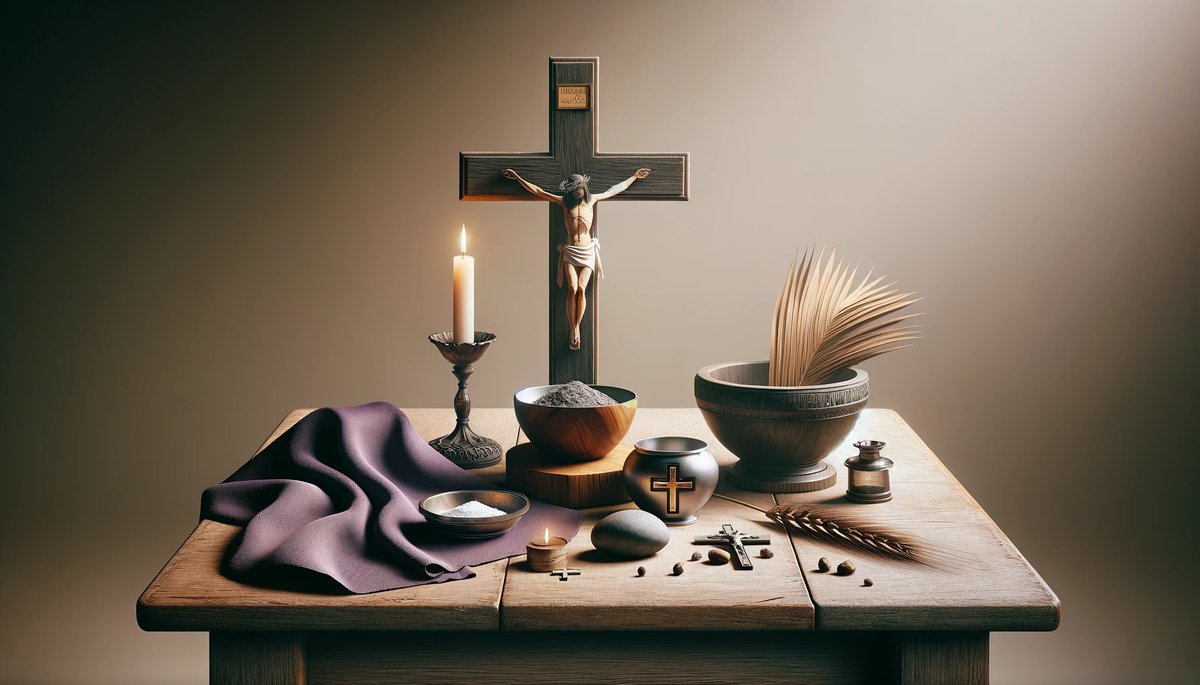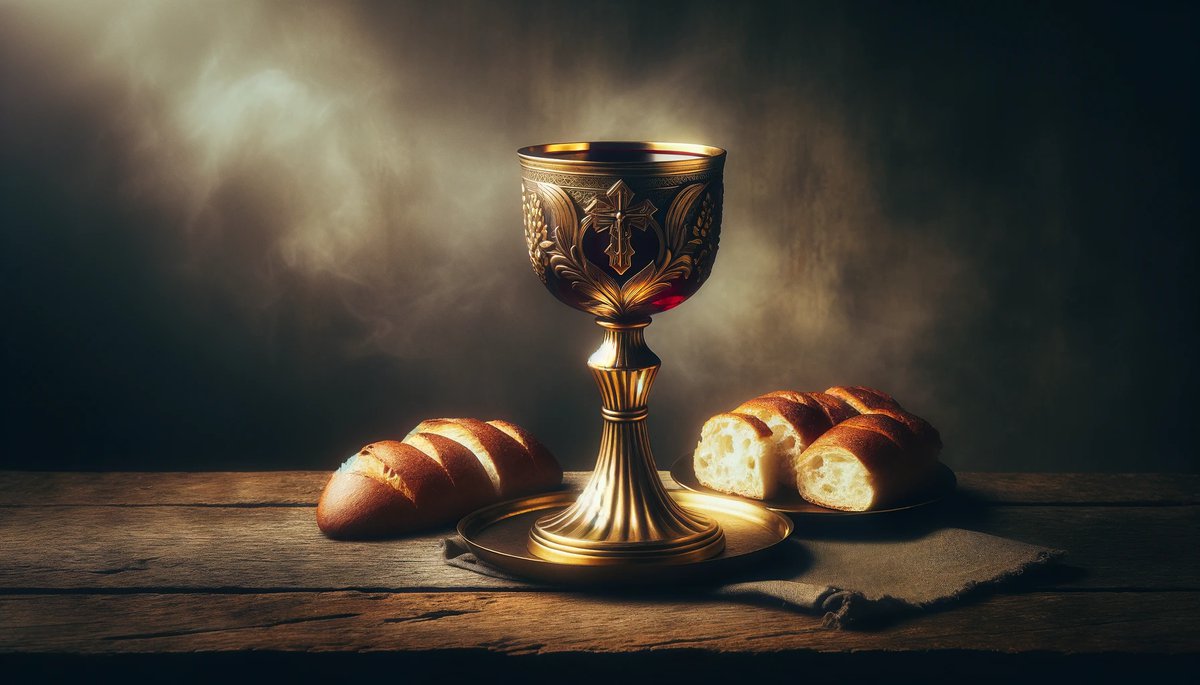Home>Special Themes>What Are Symbols Of Lent


Special Themes
What Are Symbols Of Lent
Published: February 27, 2024
Peter Smith, Editorial Director at Christian.net, combines deep insights into faith, politics, and culture to lead content creation that resonates widely. Awarded for his contributions to religious discourse, he previously headed a major organization for religious communicators, enhancing dialogue on faith's societal impacts.
Discover the significance of special Lenten symbols and their role in the observance of this sacred season. Explore the meaning behind these special themes and their importance in Lenten traditions.
(Many of the links in this article redirect to a specific reviewed product. Your purchase of these products through affiliate links helps to generate commission for Christian.net, at no extra cost. Learn more)
Table of Contents
The Meaning of Lenten Symbols
Lenten symbols hold deep significance in the Christian faith, representing various aspects of the Lenten season. These symbols serve as visual reminders of the spiritual journey of self-reflection, repentance, and preparation for the celebration of Easter. They are rich in meaning and provide a tangible way for believers to engage with the core principles of Lent. The symbols of Lent are not merely decorative; they are powerful tools for contemplation and spiritual growth. Each symbol carries its own unique message, contributing to the overall experience of Lent for Christians around the world.
-
Ashes: The use of ashes on Ash Wednesday symbolizes repentance and mortality. It serves as a reminder of human frailty and the need for forgiveness. The ashes, typically derived from the burning of palm branches from the previous year's Palm Sunday, are imposed on the foreheads of believers in the shape of a cross, signifying the call to turn away from sin and return to God.
-
Purple Robes and Drapes: The color purple, prominently featured during Lent, represents penance, preparation, and royalty. It reflects the somber and reflective nature of the season, as well as the anticipation of the resurrection of Christ. The use of purple drapes in churches and the donning of purple robes by clergy members serve as visual cues for the Lenten journey.
-
The Crown of Thorns: This powerful symbol represents the suffering and sacrifice of Jesus Christ. It serves as a poignant reminder of the pain endured by Jesus during his crucifixion. The crown of thorns is a tangible representation of the ultimate sacrifice made for the redemption of humanity.
-
The Stations of the Cross: These visual representations of Jesus' journey to the cross provide a powerful symbol of reflection and meditation during Lent. The stations depict the events leading up to the crucifixion, allowing believers to engage with the suffering and sacrifice of Jesus in a profound and personal way.
-
Fasting and Abstinence: While not tangible symbols in the traditional sense, the practices of fasting and abstinence are deeply symbolic of self-discipline, spiritual purification, and solidarity with the suffering of Christ. These acts of self-denial and moderation are central to the Lenten experience, serving as symbolic gestures of devotion and sacrifice.
The Lenten symbols carry a profound spiritual weight, guiding believers through a period of introspection, repentance, and anticipation. They provide a visual and tactile means of connecting with the core themes of the Lenten season, enriching the spiritual journey towards Easter.
Read more: What Is The Symbol Of Holy Communion
Traditional Lenten Symbols
-
Ashes: The use of ashes on Ash Wednesday symbolizes repentance and mortality. It serves as a reminder of human frailty and the need for forgiveness. The ashes, typically derived from the burning of palm branches from the previous year's Palm Sunday, are imposed on the foreheads of believers in the shape of a cross, signifying the call to turn away from sin and return to God.
-
Purple Robes and Drapes: The color purple, prominently featured during Lent, represents penance, preparation, and royalty. It reflects the somber and reflective nature of the season, as well as the anticipation of the resurrection of Christ. The use of purple drapes in churches and the donning of purple robes by clergy members serve as visual cues for the Lenten journey.
-
The Crown of Thorns: This powerful symbol represents the suffering and sacrifice of Jesus Christ. It serves as a poignant reminder of the pain endured by Jesus during his crucifixion. The crown of thorns is a tangible representation of the ultimate sacrifice made for the redemption of humanity.
-
The Stations of the Cross: These visual representations of Jesus' journey to the cross provide a powerful symbol of reflection and meditation during Lent. The stations depict the events leading up to the crucifixion, allowing believers to engage with the suffering and sacrifice of Jesus in a profound and personal way.
-
Fasting and Abstinence: While not tangible symbols in the traditional sense, the practices of fasting and abstinence are deeply symbolic of self-discipline, spiritual purification, and solidarity with the suffering of Christ. These acts of self-denial and moderation are central to the Lenten experience, serving as symbolic gestures of devotion and sacrifice.
The traditional Lenten symbols carry a profound spiritual weight, guiding believers through a period of introspection, repentance, and anticipation. They provide a visual and tactile means of connecting with the core themes of the Lenten season, enriching the spiritual journey towards Easter.
Modern Lenten Symbols
-
Digital Fasting: In the modern age, the concept of fasting has extended beyond abstaining from food. Many individuals choose to engage in "digital fasting" during Lent, which involves taking a break from social media, electronic devices, and other digital distractions. This symbolic act of disconnecting from the virtual world serves as a reminder to focus on spiritual nourishment and reflection, reducing the noise of modern life to create space for contemplation and prayer.
-
Environmental Stewardship: As environmental concerns become increasingly prominent, some Christians have incorporated environmental stewardship as a modern Lenten symbol. This may involve participating in eco-friendly practices, such as reducing energy consumption, minimizing waste, or engaging in conservation efforts. By intertwining environmental consciousness with Lenten observance, individuals symbolically align themselves with the care and preservation of God's creation.
-
Inclusive Symbols of Repentance: In contemporary contexts, there is a growing emphasis on inclusive symbols of repentance that resonate with a diverse range of individuals. This may include acknowledging and addressing systemic injustices, advocating for social equality, and promoting compassion and understanding across various communities. These modern symbols of repentance reflect a broader understanding of the Lenten journey and the call to seek reconciliation and justice in the world.
-
Artistic Expressions: Modern Lenten symbols also encompass artistic expressions that convey the themes of Lent in innovative ways. This may involve creating visual art, music, or other creative works that explore the spiritual significance of the season. Through artistic endeavors, individuals can symbolically engage with the Lenten narrative, expressing their reflections and experiences through diverse forms of creativity.
-
Acts of Service and Advocacy: In contemporary Lenten practices, symbols of service and advocacy play a prominent role. Engaging in acts of kindness, volunteering for charitable causes, and advocating for marginalized communities serve as modern symbols of embodying Christ's teachings of compassion and social justice. These actions symbolize a commitment to living out the principles of Lent through tangible, impactful gestures of love and solidarity.
The emergence of modern Lenten symbols reflects the evolving landscape of faith expression and the integration of contemporary issues into the Lenten observance. These symbols provide avenues for individuals to connect with the spiritual essence of Lent in ways that resonate with the complexities of the modern world.
Symbolism in Lenten Practices
The Lenten season is replete with symbolism that permeates various religious practices, enriching the spiritual journey of believers. These symbols are not merely superficial adornments; they carry profound meanings that guide individuals through the transformative period of Lent. The following are some key aspects of symbolism in Lenten practices:
1. Rituals of Repentance and Renewal
The rituals observed during Lent, such as the imposition of ashes on Ash Wednesday and the sacrament of reconciliation, hold deep symbolic significance. The act of receiving ashes symbolizes the acknowledgment of human frailty and the commitment to repentance and renewal. Similarly, the sacrament of reconciliation embodies the symbolic journey of seeking forgiveness and spiritual cleansing, aligning with the core themes of Lent.
Read more: What Are The Symbols For Baptism
2. Prayer and Contemplation
Prayer and contemplation are integral to the Lenten experience, serving as symbolic practices of spiritual introspection and connection with the divine. The act of engaging in extended periods of prayer, meditation, and reflection symbolizes the cultivation of a deeper relationship with God, as well as the earnest exploration of one's faith and purpose. Through prayer, individuals symbolically express their devotion and seek guidance for their spiritual journey.
3. Acts of Self-Denial and Sacrifice
The practice of fasting and abstinence during Lent carries profound symbolic weight. By voluntarily abstaining from certain foods or luxuries, individuals symbolically align themselves with the self-discipline and sacrifice exemplified by Jesus Christ. These acts of self-denial serve as tangible expressions of devotion, solidarity with the suffering of Christ, and a means of focusing on spiritual nourishment over material indulgence.
4. Almsgiving and Charity
The tradition of almsgiving during Lent symbolizes the spirit of generosity, compassion, and social responsibility. By engaging in acts of charity and supporting those in need, individuals symbolically embody the teachings of Christ regarding love for one's neighbor and the alleviation of suffering. Almsgiving serves as a tangible expression of empathy and solidarity with the marginalized, reflecting the transformative impact of love in action.
5. Participation in the Stations of the Cross
The symbolic journey through the Stations of the Cross provides a visual and contemplative representation of Jesus' suffering and sacrifice. By participating in the Stations of the Cross, individuals symbolically immerse themselves in the narrative of Christ's journey to the crucifixion, fostering a profound sense of empathy, gratitude, and spiritual connection. This symbolic practice invites believers to reflect on the redemptive power of Christ's sacrifice and the call to embody his teachings in their lives.
The symbolism inherent in Lenten practices serves to deepen the spiritual engagement of individuals, fostering a meaningful and transformative experience. These symbolic acts and rituals provide avenues for believers to embody the core principles of Lent, fostering spiritual growth, and renewal.
Read more: What Is The Symbol Of Advent?
The Role of Symbols in Lenten Observance
Symbols play a pivotal role in the observance of Lent, serving as tangible expressions of the spiritual journey and enriching the depth of the Lenten experience. These symbols are not mere visual adornments; they are powerful conduits through which believers engage with the core themes of repentance, sacrifice, and renewal. The role of symbols in Lenten observance encompasses several significant aspects that contribute to the profound impact of the season:
1. Facilitating Contemplation and Reflection
Lenten symbols serve as visual cues that prompt individuals to engage in deep contemplation and reflection. The imagery of ashes, the crown of thorns, and the stations of the cross provides tangible focal points for meditation, inviting believers to immerse themselves in the narrative of Christ's sacrifice. These symbols evoke a sense of solemnity and introspection, guiding individuals to ponder the significance of Christ's journey and the call to spiritual renewal.
2. Anchoring Spiritual Teachings
The symbols of Lent serve as anchors for essential spiritual teachings, encapsulating profound truths within their visual representation. The use of purple robes and drapes communicates the themes of penance and preparation, while the crown of thorns embodies the sacrificial nature of Christ's mission. These symbols function as mnemonic devices, encapsulating complex theological concepts in tangible forms that resonate deeply with believers, reinforcing the foundational teachings of the Christian faith.
3. Fostering Emotional Connection
Lenten symbols evoke powerful emotional responses, fostering a deep sense of connection with the narrative of Christ's suffering and redemption. The visual representation of the crown of thorns and the stations of the cross elicits empathy and gratitude, inviting individuals to emotionally engage with the transformative impact of Christ's sacrifice. These symbols create a visceral link to the core tenets of Christian belief, fostering a profound emotional resonance that underpins the Lenten observance.
Read more: What Is The Symbol Of Catholicism
4. Guiding Ritual and Practice
The symbols of Lent provide a framework for ritual and practice, guiding believers through the observance of specific Lenten traditions. From the imposition of ashes to the participation in the stations of the cross, these symbols delineate the sequence of rituals that mark the Lenten journey. They serve as visual markers that punctuate the season, guiding individuals through the spiritual disciplines and practices that define the Lenten observance.
5. Encouraging Symbolic Action
Lenten symbols inspire symbolic action, prompting individuals to embody the principles they represent through tangible gestures and behaviors. The act of receiving ashes symbolizes the commitment to repentance, while the practice of almsgiving reflects the spirit of generosity and compassion. These symbols catalyze meaningful actions, encouraging believers to translate the symbolic significance of Lent into concrete expressions of faith, love, and service.
In essence, the role of symbols in Lenten observance is multifaceted, encompassing their function as catalysts for contemplation, carriers of spiritual teachings, elicitors of emotional connection, guides for ritual, and inspirations for symbolic action. These symbols infuse the Lenten season with depth and resonance, providing a rich tapestry through which believers engage with the transformative power of Christ's sacrifice and the call to spiritual renewal.












